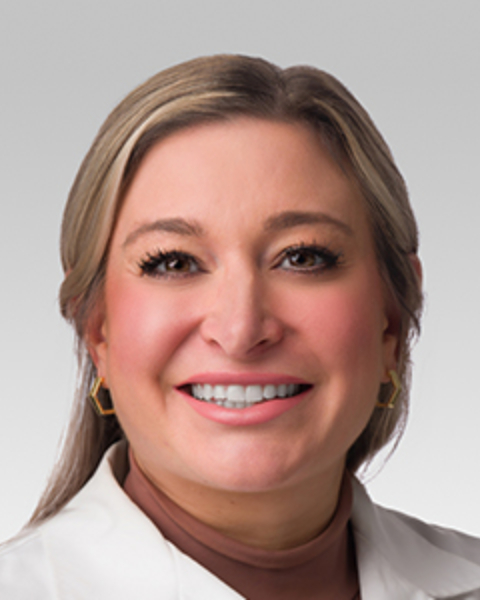PQA 06 - PQA 06 Biology and Patient Reported Outcomes/QoL/Survivorship Poster Q&A
2831 - Survivorship Therapy after RadiOtherapy for head/Neck cancer: opportunities for Growth (STRONG)
Monday, September 30, 2024
5:00 PM - 6:00 PM ET
Location: Hall C
Screen: 9

Alexis Larson, MSN, OCN, APRN
Northwestern Memorial Hospital
Chicago, IL
Presenter(s)
A. Larson1, Y. Ma1, J. Kingsbury2, K. O. Stepan3, A. Akhtar1, L. J. Mady4, P. Yadav1, B. B. Mittal5, Z. Sun6, and L. A. Gharzai7; 1Northwestern Memorial Hospital, Chicago, IL, 2Northwestern Memorial Hospital, Chicago, IL, United States, 3Head and Neck Multidisciplinary Clinic, Northwestern University, Chicago, IL, 4UPMC, Pittsburgh, PA, 5Department of Radiation Oncology, Northwestern University Feinberg School of Medicine, Chicago, IL, 6Northwestern University, Chicago, IL, 7Department of Radiation Oncology, University of Michigan, Ann Arbor, MI
Purpose/Objective(s): Cancer survivorship has become a central focus in oncology care due to improved survival rates. Patients with head and neck squamous cell carcinoma (HNSCC) are at high risk for long-term effects and require thorough survivorship care. We aimed to identify patient interest and needs following completion of radiation therapy (RT) for HNSCC. Materials/
Methods: We surveyed patients with HNSCC who completed RT at our tertiary care institution within the last 10 years. Study participants completed questions based on the five-domain Cancer Survivorship Framework (physical effects, psychosocial effects, cancer screening, chronic conditions, health promotion) and the Consolidated Framework for Implementation Research (interest, knowledge, barriers). Subgroup analyses by gender and length since treatment completion (=2-years vs >2-years) were performed. Frequencies, percentages, means, and standard deviations were calculated for categorical and continuous variables, respectively.
Results: Of 1,123 patients identified with email addresses, 317 patients answered =1 question (response rate 28%). Patients were 64% (n=203) male with a mean age of 64 years (SD 12), with 66% (n=209) finishing treatment >2 years prior. 36% (n=115) were interested in survivorship, 34% (n=108) prioritized survivorship, and 28% (n=88) had information related to survivorship. For survivorship domains, within physical effects, dry mouth (40%, n=126) and trouble swallowing (24%, n=75) were most bothersome. For psychosocial, 15% (n=46) reported current depression (mean PHQ2 score =3), 48% (n=158) felt mental health needs were not addressed during treatment. 51% felt that diet, exercise, and smoking were addressed (n=163). 76% (n=240) understood the importance of cancer screening. Most patients wished to address topics in 1 long visit (45%, n=142) and preferred in-person visits (60%, n=190). Potential barriers include insurance coverage and scheduling concerns. Female patients were more likely to show interest in attending visits (56% vs 31% male) and prioritizing survivorship (51% vs 30% male). Patients =2-years since treatment completion were more likely to show interest in attending visits (45% vs 35% >2-years), to prioritize survivorship care (45% vs 32% >2-years), and to have access to survivorship information (44% vs 24% >2-years).
Conclusion: In this cohort of HNSCC patients post-RT, survivorship interest and knowledge were limited. There is a substantial need for education on the definition of survivorship. Information gathered from this survey can be utilized to structure future post-RT HNSCC survivorship programs.
Purpose/Objective(s): Cancer survivorship has become a central focus in oncology care due to improved survival rates. Patients with head and neck squamous cell carcinoma (HNSCC) are at high risk for long-term effects and require thorough survivorship care. We aimed to identify patient interest and needs following completion of radiation therapy (RT) for HNSCC. Materials/
Methods: We surveyed patients with HNSCC who completed RT at our tertiary care institution within the last 10 years. Study participants completed questions based on the five-domain Cancer Survivorship Framework (physical effects, psychosocial effects, cancer screening, chronic conditions, health promotion) and the Consolidated Framework for Implementation Research (interest, knowledge, barriers). Subgroup analyses by gender and length since treatment completion (=2-years vs >2-years) were performed. Frequencies, percentages, means, and standard deviations were calculated for categorical and continuous variables, respectively.
Results: Of 1,123 patients identified with email addresses, 317 patients answered =1 question (response rate 28%). Patients were 64% (n=203) male with a mean age of 64 years (SD 12), with 66% (n=209) finishing treatment >2 years prior. 36% (n=115) were interested in survivorship, 34% (n=108) prioritized survivorship, and 28% (n=88) had information related to survivorship. For survivorship domains, within physical effects, dry mouth (40%, n=126) and trouble swallowing (24%, n=75) were most bothersome. For psychosocial, 15% (n=46) reported current depression (mean PHQ2 score =3), 48% (n=158) felt mental health needs were not addressed during treatment. 51% felt that diet, exercise, and smoking were addressed (n=163). 76% (n=240) understood the importance of cancer screening. Most patients wished to address topics in 1 long visit (45%, n=142) and preferred in-person visits (60%, n=190). Potential barriers include insurance coverage and scheduling concerns. Female patients were more likely to show interest in attending visits (56% vs 31% male) and prioritizing survivorship (51% vs 30% male). Patients =2-years since treatment completion were more likely to show interest in attending visits (45% vs 35% >2-years), to prioritize survivorship care (45% vs 32% >2-years), and to have access to survivorship information (44% vs 24% >2-years).
Conclusion: In this cohort of HNSCC patients post-RT, survivorship interest and knowledge were limited. There is a substantial need for education on the definition of survivorship. Information gathered from this survey can be utilized to structure future post-RT HNSCC survivorship programs.
